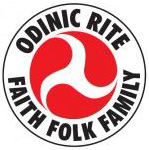Odinic Rite


The Odinic Rite (OR) is a Heathen organisation practicing a form of religion termed Odinism after the chief god of Norse mythology, Odin. It is a reconstructionist religious organization focusing on Germanic paganism, Germanic mythology, Norse paganism, and Anglo-Saxon paganism, whom some consider to be neo-völkisch.
Odinism
Current research suggests that the term "Odinism" was first used in the 1820s. It was most notably used in 1840 by the Scottish writer, historian, and philosopher, Thomas Carlyle where it is used on pages 138 and 144 of his book, On Heroes, Hero-Worship, and The Heroic in History: "Odinism was Valour; Christianism was humility, a nobler kind of Valour."
It was later used, and often mistakenly referred to as being coined by, Orestes Brownson in 1848, in his 1848 Letter to Protestants.[1] The term was re-introduced in the late 1930s by Alexander Rud Mills in Australia with his First Anglecyn Church of Odin and his book, The Call of Our Ancient Nordic Religion.[2] In the 1960s and early 1970s, Else Christensen's Odinist Study Group and later the Odinist Fellowship brought the term into usage in North America.
Today the Odinic Rite defines Odinism as the modern day expression of the ancient religions which grew and evolved with the Indo-European peoples who settled in Northern Europe and came to be known as "Germanic". The Odinic Rite shuns such descriptions as "Viking religion" or "Asatru" insisting that the Viking era was just a very small period in the history and evolution of the faith.[3]
History
In 1973 John Gibbs-Bailey (known as "Hoskuld") and John Yeowell (known as "Stubba", 1918–2010) founded the Committee for the Restoration of the Odinic Rite or Odinist Committee in England.[4] Yeowell had been a member of the British Union of Fascists in his teens (1933–1936).[5] In 1980 the organisation changed its name to The Odinic Rite after it was believed that it had gained enough significant interest in the restoration of the Odinic faith.
In 1989 Yeowell resigned as Director of the OR's governing body, the Court of Gothar. The Court then unanimously elected Heimgest as its Director and he was officially installed in this position on 23 April 1989 at the White Horse Stone in Kent. He was professed by Freya Aswynn.[6] Prior to his involvement with the Odinic Rite Heimgest had belonged to a small group known as the Heimdal League,[7] a closed group which disbanded in the mid 1980s. Some members of this group joined Heimgest in moving to the OR as they considered it had "the potential to best present the ancestral religion of Odinism to the modern world".[8] Heimgest remains the Director of the Court of Gothar.
John Yeowell resigned from the Court of Gothar entirely in 1991 and left the Odinic Rite.
In 1996 Yeowell was accepted back into the official OR.
Structure
The OR has national branches in France (ORF), North America (ORV, 1997) and the Netherlands (ORN, 2006)[9] and individual members spread over many other countries. The Odinic Rite has legal status in the United Kingdom, and the United States. The completely independent Odinic Rite of Australia has legal status in Australia.
Politics
The OR website has a disclaimer to the effect that they are politically neutral and that members who involve themselves in political activity do so as private individuals not as representatives of the Odinic Rite.[10]
Values
Members of the Odinic Rite are encouraged to live their lives according to the Nine Noble Virtues and the Nine Charges which were "codified from The Hávamál and The Sigrdrífomál (poems from the Elder Edda) in the early 1970s."[11]
The Book of Blotar
The Book of Blotar is a book of rituals published by the Odinic Rite for the purposes of celebrating Odinism.
The Book of Blots
The Book of Blots is a 1991 book of rituals written by John Yeowell and published by the Odinic Rite. An unauthorised second edition was published in 2014 by the independent Odinic Rite of Australia [12]
In popular culture
In 1997 the Director of Gothar, Heimgest, performed galdr – a magical chanting of the runes – on the Sol Invictus album The Blade.[13]
See also
- Ásatrú Alliance
- Asatru Folk Assembly
- Ásatrú in the United States
- Germanic Neopaganism
- Stephen McNallen
- Neopaganism
- Neopaganism in the United Kingdom
- White Horse Stone
References
- ^ The Works of Orestes A. Brownson: Containing the Second Part of the Political Writings, ed. Henry Francis Brownson, T. Nourse (1884), p. 257
- ^ Mills, Alexander Rud (1957). The Call of Our Ancient Nordic Religion. Northern World Pub.
- ^ "Odinism - A Defining Moment". A talk by Hengest Thorsson, later published in Odinic Rite Briefing, issue 113, 2009
- ^ Pagan Resurrection by Richard Rudgley (2006) p.240
- ^ Osred, "A multi-faceted life", obituary originally (2010) published in the Friends of Oswald Mosley newsletter, re-published in This is Odinism, Renewal Publications (2016), p. 105
- ^ http://www.aswynn.com/interviews/60-interview-for-vor-tru-magazine.html
- ^ Pagan Resurrection by Richard Rudgley(2006)p.239
- ^ personal conversation with Heimgest
- ^ www.odinist.nl Archived 2007-09-28 at the Wayback Machine
- ^ Odinic Rite FAQ Archived 2011-01-05 at the Wayback Machine - Does the Odinic Rite take a political viewpoint?
- ^ Nine Noble Virtues and Nine Charges from the Odinic Rite web site
- ^ odinicriteofaustralia.wordpress.com
- ^ www.fluxeuropa.com Sol Invictus, the Blade, review Archived 2007-03-16 at the Wayback Machine
External links
- Odinic Rite website
- Odinist Discussion Forum
- White Horse Stone
- History of the Odinic Rite of Australia
- Odinism.net (General Information on Odinism)
